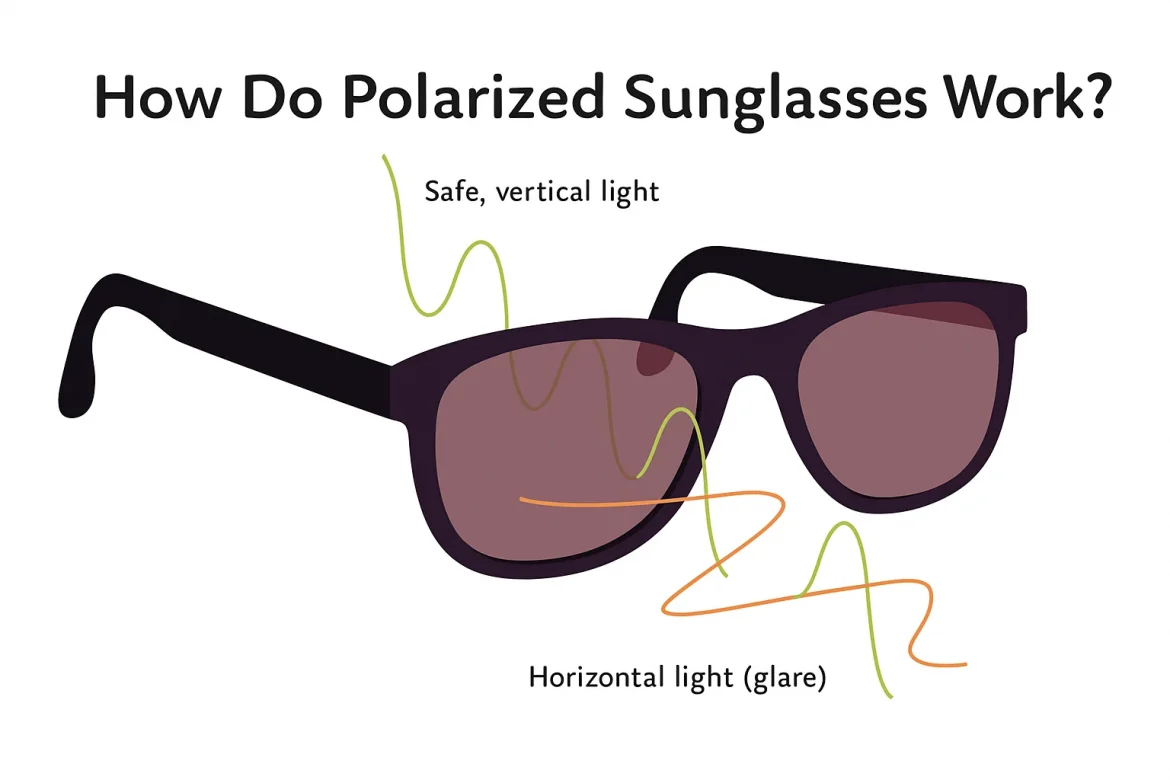Polarized sunglasses are a favorite among people who spend time outdoors. Unlike regular sunglasses that just darken your view, polarized lenses are designed to reduce glare and improve visual clarity in bright environments.
Understanding how these lenses work will help you make better choices for your eye comfort and safety. Whether you’re driving, fishing or walking on a sunny day, polarized sunglasses can enhance your visual experience and reduce eye strain.
In this blog we’ll break down how polarized lenses work, how they’re made and why they’re useful in daily life.
You’ll also learn where and when to use them and how to tell if your sunglasses are really polarized.
What Is Polarization?
Light travels in waves, all directions. When sunlight reflects off smooth flat surfaces like water, snow or glass, it becomes concentrated in one direction, usually horizontal. This concentrated light is what we see as glare.
Glare makes it hard to see clearly, forces your eyes to squint and work harder. It can also reduce contrast, distort colors and increase the risk of eye strain or accidents, especially while driving or doing outdoor sports.
What Polarization Does
Polarization helps control how light enters your eyes. When sunlight reflects off flat surfaces like water, glass, or pavement, it often bounces in a harsh, horizontal direction. This creates glare, which can make it hard to see clearly and causes your eyes to work harder.
Polarized lenses are designed to block these horizontal light waves. They have a special filter built into the lens that only allows vertical light to pass through. The result? Glare is greatly reduced, and your vision becomes clearer and more comfortable.
By cutting out glare:
- You squint less in bright environments
- Visual details become sharper and easier to see
- Colors appear more vivid and natural
- Eye strain and fatigue are significantly reduced
How Polarized Lenses Are Made
The Polarizing Film
The key to polarized sunglasses is a thin layer of chemical film, usually made from a special kind of plastic. This film is aligned in a specific way to block horizontal light.
It’s like how blinds on a window block sunlight depending on how they’re angled.
Blocking Unwanted Light
Once the film is applied, it acts like a tiny filter. It lets only vertical light through and blocks the intense horizontal light waves that cause glare. That’s what makes polarized lenses glare-cutting.
Lens Integration
The polarizing film is either:
- Laminated between two layers of lens material, or
- Applied directly to the surface of the lens, depending on the manufacturer.
So the lens looks like any other but performs way better in bright, reflective environments. Some lenses may also have UV protection, tinting or additional coatings for scratch resistance and durability.
How Polarized Sunglasses Work & Reduce Glare
Polarized sunglasses are specially designed to reduce glare and improve visual comfort, especially in bright outdoor settings. To understand how they work, it helps to know a bit about how light behaves.
What Causes Glare?
Glare happens when sunlight reflects off flat surfaces like water, roads, snow, or glass. This reflected light travels in a horizontal direction, creating a strong, blinding brightness that can strain your eyes and make it harder to see clearly.
How Polarization Helps
Polarized lenses have a special chemical filter that is applied during the manufacturing process. This filter is designed to block horizontal light waves while still allowing vertical light waves to pass through. Since glare mostly comes from horizontal light, the lenses reduce it dramatically.
As a result, your eyes receive less harsh light and more useful, natural light. This helps you see with greater clarity, contrast, and comfort.
Real-World Examples
- Driving: Reduces glare from car hoods, windshields and wet roads, improves visibility and safety.
- Fishing and Boating: Cuts through water’s surface glare so you can see beneath it more clearly.
- Skiing or Snowboarding: Helps spot terrain changes on bright snowfields by reducing harsh reflection.
- Walking or Biking on Sunny Days: Easier to see ahead, read signs and avoid squinting.
Visual and Comfort Benefits of Polarized Lenses
Polarized sunglasses aren’t just about cutting glare – they also enhance your entire outdoor experience.
Sharper Vision and Clarity
By filtering out scattered light, polarized lenses give you a more focused view. You’ll see sharper details around you, whether reading road signs or watching waves on the beach.
Less Eye Strain and Squinting
Without glare, your eyes don’t have to work as hard to focus. This means less squinting and reduced tension around your eyes which can help prevent headaches and fatigue after long hours in the sun.

Better Color Contrast and Depth Perception
Colors look richer and more defined when you wear polarized lenses. You’ll also have an easier time judging distances and depth, which is helpful for hiking, cycling and even photography.
More Comfort for Outdoor Activities
If you spend a lot of time outside, comfort matters. Polarized sunglasses give you a soothing visual experience that helps you stay focused and relaxed, whether playing sports or just walking in the park.
Polarized vs Non-Polarized Sunglasses
Understanding the difference between polarized and non-polarized sunglasses helps you make a smarter decision based on how and where you’ll use them. While both protect your eyes from sunlight, they interact with light in very different ways.
How Each Lens Type Handles Light?
Non-Polarized Sunglasses: Reduces overall brightness and blocks some UV. But doesn’t reduce glare from reflective surfaces. You’ll still get discomfort from sunlight bouncing off roads, water or windows.
Polarized Sunglasses: Has a built-in filter that blocks horizontal light waves which are the main cause of glare. Gives you clearer and more comfortable vision in sunny or reflective conditions.
When to Choose Each
You may prefer polarized lenses if:
- You spend time near water, snow, or glass surfaces
- You drive frequently, especially during the day
- You do outdoor sports like fishing, skiing, or cycling
- You have light sensitivity or experience frequent eye strain
- You want sharper clarity and color contrast outdoors
When Polarized Sunglasses Are Most Useful?
Polarized sunglasses aren’t just a fashion statement. They’re super effective at reducing glare and improving visibility in specific situations. If you’re outdoors often, especially around reflective surfaces, polarized lenses can make a big difference in your comfort and safety.

Driving (Especially on Wet Roads)
When driving, sunlight reflecting off car hoods, windshields and wet pavement can be intense. Polarized lenses block those reflections making it easier to see road signs, vehicles and hazards. This is good for comfort and reaction time.
Water Sports (Fishing, Boating)
Sunlight reflecting off the water can be blinding. Polarized lenses cut through surface glare making it easier to see underneath. Whether you’re casting a line or navigating a boat, you’ll benefit from clearer vision and less eye strain.
Snow Activities (Skiing, Snowboarding)
Snow is one of the most reflective surfaces. On sunny days it can create a sharp glare that affects depth perception and visibility. Polarized sunglasses help you read the terrain better and protect your eyes from strain and injury on the slopes.
General Outdoor Activities in Bright Sunlight
If you walk, hike, bike or spend time at the beach, polarized lenses offer an all around better viewing experience. They reduce squinting and help you see colors and details more vividly.
Situations Where Polarized Lenses Might Not Be Ideal
Although polarized sunglasses are great, there are situations where they might not be the best choice. Knowing these can help you decide when to wear them and when to switch to something else.
Low Light or Cloudy Conditions
Polarized lenses are designed to reduce light. On overcast days or in shaded areas they can make your surroundings too dark. This can reduce your ability to see details clearly.
Viewing Digital Screens
Some digital screens, like those on smartphones, ATMs, or car dashboards, may appear dim or distorted when viewed through polarized lenses. This happens because the lenses interfere with the way light is emitted from LCD or LED displays. It can make reading screens inconvenient or even impossible at certain angles.
Aviation or Technical Settings
In certain professional environments like aviation or industrial jobs you need to see reflected light and subtle glare differences. Polarized lenses can filter out important visual information which can affect performance or safety. Pilots for example are advised not to wear polarized sunglasses while flying.
Care Tips for Polarized Sunglasses
Polarized sunglasses are an investment in your eye health and comfort. To keep them working properly and looking their best, it’s important to care for them the right way. Below are simple but essential tips that help protect the lenses and extend their lifespan.

1. Clean Them Gently and Regularly
Use a clean microfiber cloth to wipe the lenses each day. If you notice smudges or dirt, rinse the sunglasses with lukewarm water before wiping. For a deeper clean, use a lens-safe spray or solution specifically made for eyewear. Avoid using rough materials like paper towels, tissues, or your shirt, as they can cause scratches and reduce the effectiveness of the polarized coating.
2. Avoid Using Harsh Chemicals
Do not use glass cleaners, window sprays, alcohol wipes, or soaps with strong ingredients to clean your lenses. These chemicals can slowly break down the special polarized filter on the lens surface, making them less effective over time. Stick to products that are labeled safe for lenses or eyeglasses.
3. Store Them in a Protective Case
When you’re not wearing your sunglasses, store them in a sturdy, hard-shell case. This helps prevent accidental drops, pressure from heavy items, or scratching when tossed into a bag or pocket. A case also keeps dust and moisture away, which can help protect the lens coating.
4. Keep Them Out of Extreme Heat
Avoid leaving your sunglasses in hot places such as the dashboard of your car, near windows, or under direct sunlight for long periods. Heat can warp plastic frames and cause lens coatings, including the polarized filter, to break down or peel. Always store them in a cool, dry area when not in use.
5. Handle with Clean, Dry Hands
Before touching your lenses, make sure your hands are clean and dry. Oils, lotions, and dirt from your fingers can transfer to the lenses, leaving smudges or sticky spots that are hard to clean. Clean hands also reduce the risk of scratching the lens when wiping them.
6. Inspect for Damage Over Time
Even with good care, lenses may show signs of wear after months or years. Look for scratches, cloudiness, or reduced glare-blocking performance. If your view becomes less sharp or your eyes start to feel strained again, it might be time to replace your sunglasses.
Conclusion
Polarized sunglasses are more than just a fashion statement. They block harsh glare from surfaces like water, roads, snow and glass and give you clearer and more comfortable vision.
By filtering out horizontal light waves and only letting through vertical light they improve clarity, reduce eye strain and make outdoor activities more enjoyable.
Whether you’re driving, fishing, skiing or just spending time outside polarized lenses can make a big difference in how well you see and how relaxed your eyes feel. They may not be suitable for every situation like using certain digital screens or in low light but they are great for bright and reflective environments.
Taking care of your lenses and knowing when to use them will get you the most out of your sunglasses. Investing in a good pair will give you better eye comfort, improved safety and a more enjoyable outdoor experience.
FAQs
What does polarization mean in sunglasses?
Polarized sunglasses have a built-in filter that blocks horizontal light waves, the ones responsible for glare from surfaces like water, roads or snow. This allows only vertical light to pass through and gives you glare-free vision.
2. How can I test if my sunglasses are polarized at home?
Hold your lenses in front of an LCD screen (like your phone or laptop). Rotate the sunglasses 60-90°. If the screen darkens or turns black, your lenses are polarized.
3. Do polarized sunglasses protect against UV radiation?
Polarization itself doesn’t filter UV light. However most polarized lenses also have a UV400 rating which blocks nearly all UVA and UVB rays – protecting your eyes from long term sun damage.
4. Are polarized lenses always better than non-polarized lenses?
Not always. Polarized lenses are great at reducing glare and improving clarity in bright outdoor conditions but can distort LCD screens and be too dark in low light or overcast conditions.
5. Can polarized sunglasses help with eye strain and headaches?
Yes. By eliminating glare and harsh reflections, polarized lenses reduce the need to squint and lessen visual fatigue. This often results in fewer headaches during prolonged sun exposure.
6. Do polarized lenses affect how screens look?
They can. Some LCD or LED screens (like smartphones, dashboards or ATMs) may appear dim, distorted or even unreadable when viewed through polarized filters depending on the angle.
7. Are polarized sunglasses more expensive than regular ones?
Yes. Polarized lenses involve extra manufacturing steps, like embedding a special filter, which adds to the cost compared to non-polarized sunglasses.


